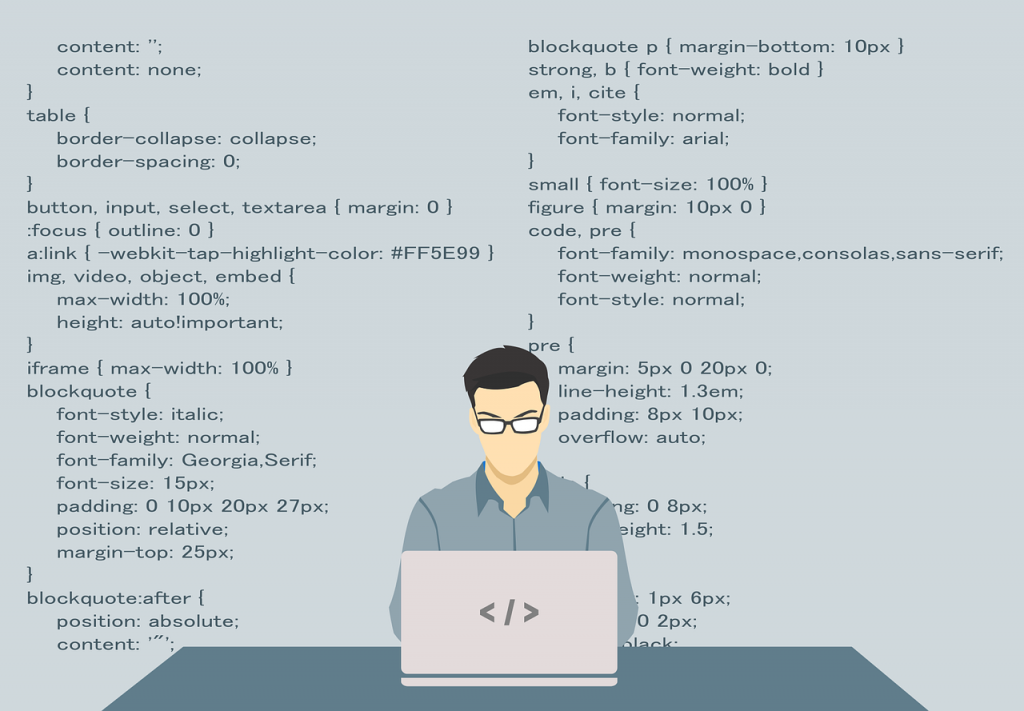Last Updated on: August 19, 2022
In our previous blog, we tried to help you giving insights about Web Development and various career perspective around it. Have you made up your mind to get into it already?. By now, you must have googled the opportunities and maybe in the midway of finding a right program platform to learn and get certified in a web development course. Apart from that, It is necessary to learn about various platforms through which you can implement web development. There are a lot of languages and tools involved to carry out the web development functionalities both in front and backend.

Table of Contents
What is Front-end Development?
Front-end web development is also known as client-side development. This entails creating everything that you see on a website. The front-end elements of a website include the layout, styling of text, images, alignment, call-to-action buttons, navigation, and colours. Front-end web development is a very important part of the complete web development process. This is because it defines the responsiveness and performance of the website, which influences the user experience for visitors.
You may engage the most creative and experienced web designer, but without a good front-end web developer, the design elements cannot be incorporated into the website. Front-end web development can make the website smooth, intuitive, and seamless. It also facilitates easy debugging.
Primary Platform for Front-end Development
If you are looking for the best platform to learn front end development, it’s important to know that there are three main languages for front-end web development. These are:
HTML
HyperText Markup Language is the most widely used language for front-end web development. This markup language describes the structure of a webpage and communicates to the browser how to display the content. Thus, HTML is used to define the layout of a webpage and the formatting of the information contained within it. This makes the content of the webpage more interactive and dynamic.
HTML can be used for creating both websites and web apps. It is also extensively used for game development and creating responsive user interfaces.
CSS
Cascading Style Sheets describe how HTML elements will be displayed on any media, which could be a computer screen. It is also a very commonly used language for front-end web development. CSS is essentially a design language, which simplifies creating the look and feel of webpages. It contains selectors that can be used to choose elements and apply styles to them. This makes CSS very easy to use and time efficient.
CSS is widely used for browsers like Chrome, Edge, and Firefox.
JavaScript
JavaScript is a popular front-end programming language. The main purpose of this open-source language is to enhance a webpage’s user experience by animating images and creating dynamically updating content. As of 2022, as many as 98% of websites were using JavaScript to increase visitor engagement.
Apart from websites, JavaScript is widely used in mobile app and game development. It is extremely easy to use and maintain.
To gain comprehensive insight into such languages, consider GeekLurn’s Full Stack Web Developer certification program. With 120+ hours of live online sessions, 24/7 access to the LMS portal, and experience in handling real-time projects, this course is a wonderful way to kickstart your career as a professional web developer.
Best Front-end Web Development Learning Platform
Wondering what is the best front-end web development learning platform? Here are a few things to know:
1. Sublime Text:
Sublime Text is a first-rate cross-code editor which supports many programming and markup languages. It allows making multiple changes simultaneously on different pages with simultaneous editing. It is enabled with Python-based plugins and matches keyboard invocation with primary commands.
2.JQuery:
JQuery is one among the most popular Javascript libraries. It is a major tool, front end developers rely on. It makes HTML documentation easy. It is an open-source library for free. It has access to the dynamic theme mechanism and is highly interactive in nature when it comes to the web application.
3.AngularJS:
AngularJS is an open application framework, and must be a known tool for front end developers. It has an accessible and expressive environment which helps in extending HTML syntax. For every user, it handles exclusive javascript code using MVC.Angular.JS has been developed by Google.
4.Sass:
It is another tool used by front end developers. Sass is a CSS extension language which is active, powerful and robust. It renders an extended hand in solving existing CSS functionalities. Sass mainly reinforces language extension parameters like variables and nesting. It promotes manipulative functionalities like colours and control directives of libraries. It yields customised output and is straightforward with formats.
5.Grunt:
Grunt is a famously adopted task runner on NodeJs used by front end developers. It provides task automation with a wide range of plugins. It minimises the effort with a repetitive task. It encourages easy workflow when it comes to setting up a file. For carrying forward the functionality of scripts, it is enabled with various built-in formats. It enhances the efficiency of the process by accelerating the Grunt ecosystem.
6.Twitter Bootstrap:
Front end developers use this widely used bootstrap framework created by Twitter. It helps you to get rid of redundancy. With the regular and same patterns emerging again and again on the container, it selectively extracts the common elements and ties them into reusable modules. It helps in normalising stylesheets, building modal objects and adding javascript plugins.
7.Codepen:
Codepen is a development environment used by front end designers. It is helpful in deploying websites and creating test cases. It is an accelerated platform which makes the usability smoother and faster. It is so enabled with already existing API features sp that no added code lines needed to be written.
8.GitHub:
If you are working on a new project, and you accidentally screw up midway, GitHub is there to rescue. Github, you can also term it as version control systems (VCS).
It facilitates the environment with adaptable components like bug tracking, feature request, task management. The repository hosting services help to boast a rich open-source development community.
9.HTML5 Boilerplate:
It is a primary set of files which makes the foundation for any website. It builds a CSS bug fixing approach with an apache server which helps in configuring security and improving the security. It inhibits javascript error and protects against console statements.
10.WebStorm:
It makes javascript look smart. It is a coding assistance platform which extends hands to Angular, React.js, Vue.js and Meteo.
While undertaking large projects, it traces, debugs and tests client-side applications with built-in features. It is customised to support various coding styles.
11.Typescript:
Typescript is a superset of Javascript which adds additional typing features to the existing. It runs in sync with Javascript in parallel. It can carry information from already existing javascript files and c/c++ libraries. It is highly portable across operating systems and browsers.
12.Chrome Developer Tools
Google offers built-in Chrome Developer Tools, which are extremely useful as they help you edit HTML, and CSS JavaScript in real-time. If you find an error in your HTML or a bug in your JavaScript, you can easily make the changes while viewing the performance analysis of your website.
There are tools that allow you to access the programming of your web application. There is also a range of network tools to help you optimise loading flows, while viewing a timeline that gives you all the information around the browser’s activity at any given point in time.
It’s a good idea to stay abreast of the latest updates, which Google releases every few weeks. You can do this by regularly checking Google’s site or subscribing to the Google Developers YouTube channel.
13. jQuery
JavaScript makes websites much more fun, with dynamic content and amination. However, there are some issues arising from people accessing the website from the many versions of browsers simultaneously in existence. Here’s where developers need jQuery. This allows the proper functioning of JavaScript.
Launched in 2006, jQuery is a fast cross-platform JavaScript library that makes the front-end process significantly simpler. It allows you to achieve more creative animations, easily add plug-ins, and do a host of other tasks that would otherwise have been highly time consuming.
Offering these advantages, jQuery gained popularity very quickly. As of 2019, jQuery was being used in more than 70% of the most popular websites.
14. React
React helps enhance the user interface of webpages. Written in JavaScript, this UI development library is run by Facebook and an open-source developer community. Although React began as a library for UI development, there are now several extensions (like Flux and React Native) available for supporting the complete application architecture.
React has gained immense popularity since its launch in May 2013. It has emerged as one of the most widely used libraries for front-end web development.
There are two features of React worth mentioning:
- JSX – This makes the code simpler to understand and debug. This is done by avoiding the use of JS DOM structures, which are very complex.
- Virtual DOM – This updates an object when its state changes. However, the update is made in the real DOM instead of in all.
15.Vue
Vue is also an open-source framework written in JavaScript. Offering advantages like high flexibility, two-way communication, and faster performance, Vue has become very popular for developing user interfaces and single-page applications.
When there is a change in the HTML, Vue uses virtual DOM to update that particular HTML instead of the entire tree, ensuring a faster and bug-free update. It is also able to select the best method for updating the element, based on the input type.
16. Swift
This is a simple, yet powerful programming language used for iOS, iPadOS, macOS, tvOS, and watchOS. Swift allows a low-cost and safety-first approach and is supported by a large community. Swift code is interactive and expressive. This programming language also incorporates several modern features, offering more flexibility for developers.
Conclusion
If you are interested in any or all these languages and tools and would like to build a career in the exciting field of front-end web technologies, it’s a great time to explore the best platform to learn front end development from the beginning. With GeekLurn’s Full Stack Web Developer certification program, you can easily learn these front-end technologies and enjoy a lucrative and successful career in web development.






